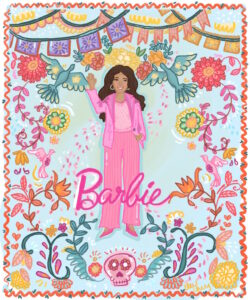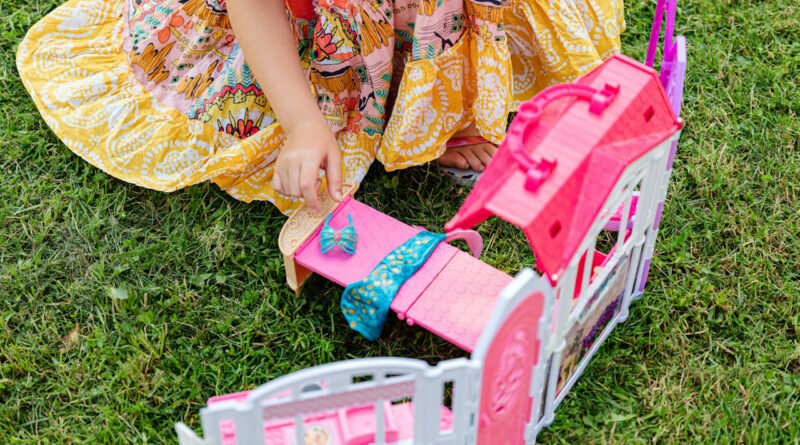Come on, Barbie
Come on, Barbie, let’s go dismantle the Patriarchy
by Erica Kim
 When Greta Gerwig’s Barbie hit theaters, it was a Mattel-pink disco party heard around the world. Between sequences of magical events and elaborate dance numbers, Gerwig tries to capture as much of the human experience under capitalism and the patriarchy as possible. Barbie’s portrayal has evolved, reflecting broader cultural shifts and aspirations. The release of Barbie amplified these discussions, particularly within the LatinX community, where the impact of Barbie resonates in nuanced ways.
When Greta Gerwig’s Barbie hit theaters, it was a Mattel-pink disco party heard around the world. Between sequences of magical events and elaborate dance numbers, Gerwig tries to capture as much of the human experience under capitalism and the patriarchy as possible. Barbie’s portrayal has evolved, reflecting broader cultural shifts and aspirations. The release of Barbie amplified these discussions, particularly within the LatinX community, where the impact of Barbie resonates in nuanced ways.
The attention to detail and diverse casting serves as a culmination of conversations surrounding Barbie’s role in shaping cultural narratives and aspirations for future generations. Incorporating cultural elements, such as the vibrant fuchsia Rosa Mexicano, speaks to a deliberate effort to acknowledge and celebrate Latin American heritage within the Barbie universe.
However, Barbie’s legacy is not without its complexities. Growing up, many individuals, including Barbie actress America Ferrera, grappled with Barbie’s portrayal of beauty and femininity. In an interview with The Cut, Ferrera admits to not playing with Barbie as a child. The doll, with its white and Westernized features, often presented an image that didn’t fully reflect the diversity of Latin American identities. Ferrera elaborated that Barbie’s physical attributes felt “inaccessible” to her and were likely detrimental to her self-esteem1.
While approaches to beauty standards have veered away from this Eurocentric ideal, present-day mainstream preferences for Eurobodies persist. Alix Earle and Emma Chamberlain, for example, are two of the most popular “influencers” among Generation Z. Both are young, blonde, slender White women who perfectly fit the traditional Barbie archetype. Ingrained in our culture then, is an acceptance of White bodies as the norm and if you “didn’t look like Barbie, you didn’t fit in. Your status was diminished”2.
This dynamic mirrors broader societal tensions around beauty standards and cultural identity. The concept of malinchismo, which valorizes foreign influences over indigenous heritage, permeates discussions about Barbie’s impact. The doll represents both admiration and resentment, embodying unattainable standards while also symbolizing aspirations for success and beauty.Barbie and Barbie are catalysts for broader conversations within the LatinX community and beyond. Barbie tried to present a more authentic representation of diverse experiences to varying degrees of success in viewers’ eyes. Shakira went viral for saying her sons “absolutely hated [Barbie]” during her interview with Allure3. Clearly, Barbie and how she communicates feminist ideas remain polarizing. She is a Barbie girl in a world slowly working towards greater representation and equity. Barbie may not be the perfect role model for everyone, but in striking a nerve, she empowers us to demand more for ourselves.
foreign influences over indigenous heritage, permeates discussions about Barbie’s impact. The doll represents both admiration and resentment, embodying unattainable standards while also symbolizing aspirations for success and beauty.Barbie and Barbie are catalysts for broader conversations within the LatinX community and beyond. Barbie tried to present a more authentic representation of diverse experiences to varying degrees of success in viewers’ eyes. Shakira went viral for saying her sons “absolutely hated [Barbie]” during her interview with Allure3. Clearly, Barbie and how she communicates feminist ideas remain polarizing. She is a Barbie girl in a world slowly working towards greater representation and equity. Barbie may not be the perfect role model for everyone, but in striking a nerve, she empowers us to demand more for ourselves.
Illustration by Ellie Cheng and provided by Erica Kim. photo of a girl in a floral dress playing with a toy by Karolina Grabowska from pexels.com
 References:
References:
- https://www.thecut.com/article/america-ferrera-barbie-movie-profile-cut-cover-july-2023.html
- Susan Jane Gilman, Klaus Barbie, and other dolls I’d like to see (New York: Oxford University Press, 2011), 17.
- https://www.allure.com/story/shakira-cover
Erica Kim is from Chicago, Illinois. She graduated from Wellesley College with a degree in neuroscience before starting as a medical student at the University of Rochester. She is interested in making healthcare more equitable and accessible, particularly to women of color. In her free time, she enjoys running, listening to music, and discussing popular culture with her friends.


